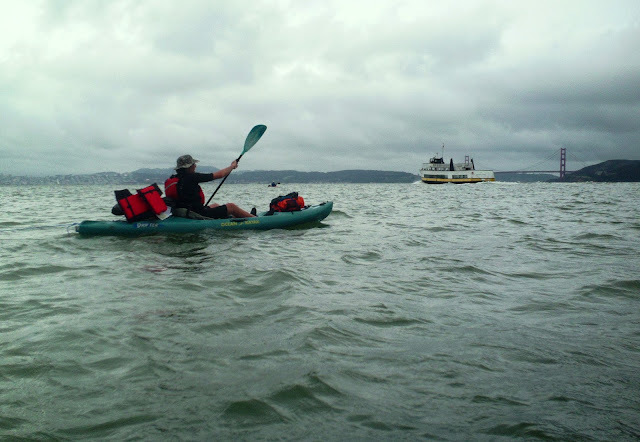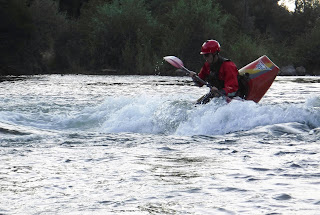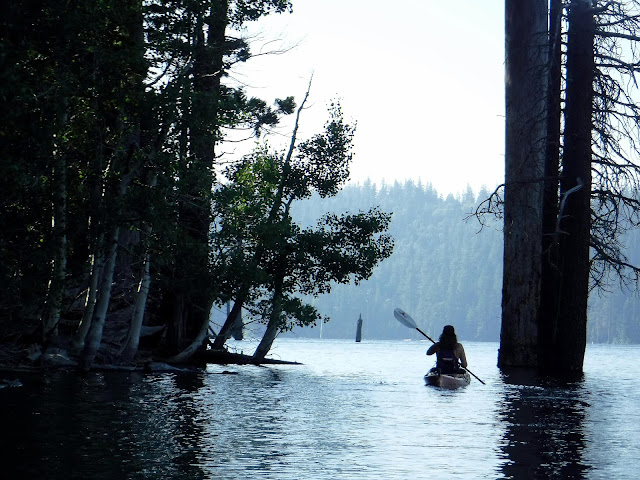It's not like crossing the street. Out of the safety of Horseshoe Bay, some of the wildest sea conditions on the entire West Coast can be found. San Francisco Bay is known for steep waves, fast and swirling currents and howling winds blowing through the Golden Gate. Adding to the chaos are the pleasure crafts, ferries and ocean-going vessels competing for the same waterway. Area guides and kayakers familiar with these water make it clear. You can't out run or beat the fast-moving ferries crossing their traffic lanes and caution should always be exercised.
"When I'm on the bay since I'm the slowest and smallest thing out there," said California paddler Mike Rumsey, "I always trying to keep my head on a swivel and aware of my surroundings ."
"It's true that we share the waterways with all vessels," added California-based sea kayaker Kathi Morrison, "But believe it or not kayaks sit on the bottom of the right of way chain. We are no match for tankers, ferries, commercial vessels or something with a motor or sail. We must paddle responsibly and defensively understanding that vessels cannot see you or react quick enough to avoid consequence."
 |
| NEW YORK DAILY NEWS |
Glare from the sun is being a possible reason for this week's accident involving a group of kayakers and a ferry on the Hudson River near Midtown Manhattan. Police say the New York Waterway ferry was leaving Pier 79 at 39th Street just before 6 p.m. when it struck 10 kayakers, sending multiple paddlers into the water. Five people were hurt, including one employee of the Manhattan Kayak Company who suffered a severe arm injury.
"He was lying on top of the kayak and there was this pool of blood and we knew that we had to go over there and assisted him priority," told Harbor Unit police officer Tommy Le to NY 1 News.
An other paddler suffered a serious head injury, while the guide had a punctured lung and a broken rib, while others were hurt with minor injuries to the shoulders and back.
 |
| NEW YORK DAILY NEWS |
“It is a minor miracle that it hasn’t happened to some other kayaker or boater or jet-skier before,” Eric Stiller, owner of Manhattan Kayak Co., the group that led the kayakers who were injured., told the
Wall Street Journal, “I tell people out here, we don’t have great white sharks. I’ve got something bigger and faster than great white sharks. Out here, we’ve got ferries,”
A preliminary investigation determined the captain of a NY Waterway ferry, backing up from Pier 79, “was unable to see the kayakers behind him” before striking them, New York Police Department Chief of Patrol Carlos Gomez told the
Wall Street Journal.
“Apparently sun glare was a factor,” Chief Gomez said. “It sets, as you know, west, and he was looking behind him and the sun kind of blocked his vision or impaired it.”
The accident highlights the risks for recreational and commercial watercraft when they share the increasingly crowded waterways. "When you have that mix you run the danger of collision between recreational and commercial mariners,” Andrew Coggins, a retired U.S. Navy commander and professor at Pace University who studies the cruise industry told the Wall Street Journal, "The collision, clearly illustrates the dangers involved in mixing commercial and recreational shipping. Commercial ships don’t always see recreational shipping and recreational shipping doesn’t always stand clear of commercial shipping.”
According to their news release,
California State Parks Division of Boating and Waterways (DBW) anticipates an increased number of recreational boaters on waterways during the upcoming Labor Day weekend and reminding boaters to following simple navigation rules can greatly decrease the chances of being involved in an accident. In 2015, 503 boating accidents, 232 injuries and 49 fatalities were
reported to DBW on the state's waterways.
“Just like highway rules, navigation rules tell boat operators about right of way, signaling to other boats and how to avoid collisions on the water,” said DBW’s Deputy Director Lynn Sadler. “Not only must boat operators keep a sharp lookout for fast moving vessels, submerged hazards or swimmers and paddle craft, they must know navigation rules in order to quickly and safely respond to changing conditions.”
Those who lead recreational kayaks and stand up paddle boards tours, should remind their clients they need to be vigilant when on the water. They also should follow safe practices, including such common-sense measures as being aware of nearby vessels, staying clear of ships and avoiding designated commercial routes.
“Whoever is in the right or in the wrong, you’re the one who is going to get hurt,” said David Matten, of Long Island City Community Boathouse, which leads recreational kayak tours on the East River in the Wall Street Journal, “You have to stay away from the ferry. It’s incumbent upon us to pay attention, where they are and where they are going.”
"Assume no one can see you and give ship traffic a wide berth," agreed Rumsey, "Know were the ferry and shipping channels are. Even around the docks is like crossing the street stop look and don't play around moving boats."
"It's easy for a large group to cross the ferry path when the ferry is at the dock," points out California kayak instructor, Byrant Burkhardt, "Actually a good idea, not knowing when it will launch but expecting the pilot would see them before taking off. The general rule when a large group crosses traffic is to stay close together to be more visible."
"Know the ferry schedule as it's easy to get displaced by their engines," added Morrison, "Stay in a close group, wear bright clothes and know that you cannot out run other vessels. Turn on your VHF radio to channel 16 monitoring all the ships."
Far off from any ferries or large boat traffic on Lake Natoma, near Sacramento, it was only crowded with small sailboats, paddle boards and dotted with kayaks. On the beach, surrounded by kayaking students
Current Adventures Kayak School and Trips instructor Kim Sprague gives the last of his pre-paddle instructions before hitting the water. He hits one of the kayaks hard with his hand exclaiming that these boats are tough. You can crash into each other and they won't break. From the back a female student raises her hand and asks what about the bigger boats?
"I just always yield to the bigger vessel,"said Sprague. Good advice when navigating congested waters.



























































